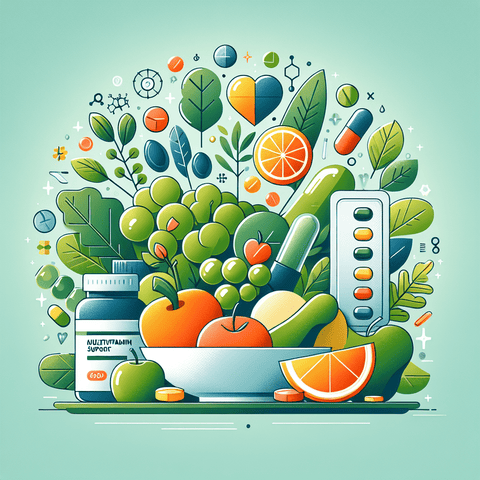Understanding Vitamin D and Its Role in Your Health: Why Supplementation Matters
Vitamin D is a fat-soluble vitamin essential to a broad range of physiological processes in the human body. Often known as the “sunshine vitamin,” it plays a central role in maintaining bone health, supporting immune function, influencing muscle function, and contributing to mood regulation. Although the body can produce vitamin D via exposure to sunlight, ensuring optimal levels isn’t as straightforward as spending a few minutes outside. With modern indoor lifestyles, geographic limitations, and seasonal changes, vitamin D deficiency has become a global concern—even in sunny regions. One of the most well-documented roles of vitamin D is its involvement in calcium and phosphorus absorption, critical for building and maintaining strong bones. Insufficient vitamin D can lead to soft bones in children (rickets) and brittle bones in adults (osteomalacia). Beyond skeletal health, vitamin D also supports innate and adaptive immunity, skin health, cardiovascular function, and even cognitive performance. Several studies suggest that deficiencies may contribute to chronic illness susceptibility, mood disorders, and autoimmune reactions. Despite its importance, achieving optimal vitamin D levels through diet alone is incredibly challenging. Natural food sources high in vitamin D are relatively scarce. Fatty fish like salmon, mackerel, and sardines are notable dietary sources, along with fish liver oils and fortified foods like milk or plant-based alternatives. However, even a diet rich in these options may not provide sufficient vitamin D, especially if your body’s needs are elevated or your sun exposure is limited. This is where vitamin D supplementation proves invaluable. Supplements offer a standardized and efficient way to bridge the gap between your body’s needs and environmental or dietary limitations. For individuals who don’t get enough sun or cannot rely on diet alone, supplements can increase vitamin D levels quickly and effectively. On platforms like Topvitamine.com’s Vitamin D collection, users can explore various supplement forms including vitamin D3 sprays, capsules, and liquid drops designed for optimal absorption. Extra consideration must be given to people at higher risk, such as those with darker skin tones (as melanin reduces vitamin D synthesis), older adults, people who are obese, and individuals with malabsorption syndromes. In such cases, even more precise intervention with supplementation is needed to restore healthy serum levels—generally measured with 25-hydroxyvitamin D (25(OH)D) blood tests. In summary, understanding the multifaceted role of vitamin D unveils the necessity for focused efforts to maintain adequate levels. Supplementation, especially with D3—the more bioavailable form—is the fastest, most reliable, and safest route for most people to raise their vitamin D levels efficiently while ensuring broader health support.Sun Exposure Secrets: How to Maximize Vitamin D Production Naturally
Sunlight exposure remains the most natural method for producing vitamin D, as ultraviolet B (UVB) rays from the sun convert 7-dehydrocholesterol present in the skin to pre-vitamin D3, which is then transformed to biologically active vitamin D. However, optimizing this natural process requires understanding several crucial variables. Firstly, the duration, timing, and quality of sun exposure matter. The ideal time to soak in sunlight is mid-morning to early afternoon when UVB rays are strongest. Depending on your skin type, exposing face, arms, and legs for 10–30 minutes a few times a week may suffice for maintaining healthy vitamin D levels. For individuals with darker skin, more time is required due to higher melanin content which naturally filters UVB radiation. However, geographic factors such as latitude and season dramatically affect UVB availability. People living above 37° latitude (north or south) may produce little to no vitamin D from sunlight during winter months. In these areas, even prolonged exposure in colder months might be ineffective, highlighting the need to either consider winter travel or rely on supplementation during those periods. Age is another significant factor. Older adults have reduced capacity in the skin to synthesize vitamin D and may therefore need either more direct sunlight or greater use of dietary and supplemental options. Likewise, sunscreen—even at SPF 15—can reduce UVB penetration by over 90%, significantly diminishing vitamin D production. While protecting the skin from burns and photoaging is important, finding a balanced approach, such as exposing the skin for short, controlled periods without sunscreen, is vital. To maximize results, sun exposure should be combined with oral vitamin D3 supplementation. As the skin-generated form (cholecalciferol or D3) and supplemental D3 are chemically identical, they complement one another seamlessly. Adding both to your regimen ensures you’re covering all bases, especially if your natural exposure isn’t consistent or reliable. For those concerned with long-term skin damage or live in climates not conducive to regular sunlight, high-quality vitamin D3 supplements are indispensable. Platforms like Topvitamine.com offer several trusted options that mimic the effects of sun-induced D3 without the risks associated with UV radiation. Used together strategically, sunlight and supplementation provide a robust, natural strategy for overcoming deficiency quickly and safely.Vitamin D Deficiency Remedies: Fast-Track Strategies to Boost Your Levels
Addressing vitamin D deficiency starts with recognizing its signs. Common symptoms may include fatigue, muscle pain or weakness, bone aches, frequent infections, depression, and impaired wound healing. Since these signs are often subtle or attributed to other causes, testing serum 25(OH)D levels with a simple blood test is the most effective diagnostic tool available. Generally, levels below 50 nmol/L (20 ng/mL) indicate deficiency, while 75–125 nmol/L (30–50 ng/mL) is considered adequate for most people. Once diagnosed, certain lifestyle and supplementation strategies can rapidly restore normal levels. Exposure to sunlight and increased consumption of vitamin D-rich foods play an important role but may not suffice for those significantly deficient. In such cases, high-dose supplements—available both over the counter and by prescription—offer a fast-track solution. Health professionals may recommend short-term intensive regimens, such as 50,000 IU per week for 6–8 weeks, followed by maintenance dosages. Always perform such protocols under medical supervision to avoid hypervitaminosis D, a condition where too much vitamin D harms the body. It’s also essential to adopt habits that enhance your body’s natural vitamin D metabolism. Adequate magnesium intake, for instance, enables 25(OH)D’s conversion into its active form, calcitriol. You can support this process with magnesium-rich foods or supplements found in categories like Magnesium for bone and muscle support. Omega-3 fatty acids also exhibit synergistic effects and are readily available through Omega-3 supplements. Monitoring progress through regular blood testing is vital during the replenishment phase. Typically, significant rises in serum levels can be observed within 8–12 weeks of consistent supplement use. Adjustments can then be made according to test results to either continue high-dose therapy or transition to a standard maintenance dose, which often ranges from 1000 IU to 4000 IU daily depending on age, weight, and health status. Quick correction of vitamin D deficiency must strike a balance between effectiveness and safety. Instead of relying solely on unverified methods or assumptions, a combined protocol involving testing, supplementation, sun exposure, and diet—guided by clinical input—ensures fast, sustainable, and medically-sound improvement in vitamin D levels.Optimal Vitamin D Absorption: Tips to Maximize Effectiveness of Your Supplements
Even if you’re consuming high doses of vitamin D, your body’s ability to absorb and utilize it depends on several critical factors. Therefore, to maximize the effectiveness of your supplementation and raise serum levels quickly, it's important to understand absorption dynamics and adopt best practices for intake. The first key factor is the form of vitamin D used. Vitamin D3 (cholecalciferol) is widely regarded as more effective than D2 (ergocalciferol) in raising serum concentrations. D3 has better binding affinity with vitamin D receptors and longer duration of activity in the body. For rapid elevation, always opt for D3 unless advised otherwise for specific medical reasons. One effective way to maximize absorption is to take vitamin D with a fat-containing meal since it’s a fat-soluble vitamin. Ideally, you’ll want to pair it with healthy fats such as olive oil, avocado, nuts, or full-fat yogurt. Many premium formulations even come in oil-based softgels or emulsified liquids for immediate absorption. Trusted formats like the sprays and oils available on the Topvitamine D3 product page are excellent options. Another significant factor affecting absorption is gut health. Individuals with gastrointestinal conditions—such as Crohn’s disease, celiac disease, or irritable bowel syndrome—may struggle with nutrient assimilation. Supporting your gut microbiome through fiber-rich foods, probiotics, and regular hydration contributes to better vitamin uptake. Certain medications may interfere with vitamin D metabolism. These include anticonvulsants, glucocorticoids, and bile acid sequestrants. If you’re using any of these long-term, consult your healthcare provider to adjust your vitamin D dosage accordingly. Timing and consistency also play pivotal roles. Vitamin D should ideally be taken at the same time every day to maintain stable blood levels. Morning administration is effective for many people and may avoid potential sleep disturbances that high nighttime doses may occasionally trigger. Finally, ensure you're also addressing cofactor nutrients such as vitamin K2. While not involved directly in absorption, vitamin K2 helps direct calcium to the bones and away from soft tissues, preventing calcification. You can find synergistic vitamin K products at Topvitamine’s Vitamin K category. In conclusion, ensuring that your supplementation approach considers form, timing, delivery type, dietary pairing, and absorption conditions will enable you to raise your vitamin D levels efficiently and sustainably.Vitamin D-Rich Foods: Natural Dietary Sources to Support Your Goals
While supplementation provides the most direct path to increasing vitamin D quickly, integrating natural dietary sources into your routine adds lasting health benefits. Including vitamin D-rich foods in your diet can help maintain optimal levels over time and work synergistically with sun exposure and supplements. Fatty fish remains the standout food category for vitamin D. Salmon (especially wild-caught), sardines, mackerel, herring, and tuna are all excellent providers, typically supplying 250–1000 IU per serving. Cod liver oil, though less commonly used today, offers an extremely high concentration with just one teaspoon delivering around 450–500 IU—and often includes beneficial omega-3s as well. Matching this with products from Topvitamine’s Omega-3 range helps boost overall nutrient intake. Egg yolks are another source of vitamin D, with levels depending on the diet of the hen. Free-range and pasture-raised chickens typically produce eggs with higher vitamin D content than their factory-raised counterparts. Meanwhile, fortified foods such as cow’s milk, plant-based milks (soy, almond, oat), breakfast cereals, orange juice, and margarine can contribute several hundred IUs per serving. These are helpful especially for vegetarians or those with limited sun exposure. Mushrooms exposed to UV light, especially maitake and portobello varieties, can also provide a vitamin D2 boost. However, because D2 is less potent than D3, dietary intake via mushrooms should not replace supplementation when levels are low. To effectively incorporate these foods into your diet, aim for diversity: Include fatty fish two to three times a week, swap your usual cereals or milks with fortified versions, and consider egg-based breakfasts. Combine these foods with vitamin D supplements for a rounded approach. Diet alone generally won’t suffice to correct deficiencies but plays a fundamental supporting role in maintaining healthy serum levels. When combined thoughtfully with supplemental forms—whether in liquid, tablet, or spray format—your long-term vitamin D strategy becomes both sustainable and nutritionally enriching.Supplement Options: Choosing the Right Vitamin D Supplements for Rapid Elevation
Choosing the best vitamin D supplement is essential in terms of effectiveness, ease of use, absorption rate, and safety. Not all supplements are created equal, and a bit of informed guidance can accelerate your journey toward optimal vitamin D levels. Start by selecting the correct form: Vitamin D3 (cholecalciferol) is more bioavailable and effective than D2. Most reputable products today offer D3 derived from lanolin (from sheep’s wool) or vegan variants made from lichen. The delivery format matters too, with popular options including softgels, chewables, liquid drops, and sprays. Each type has specific advantages. Liquid and spray formulations are particularly ideal for individuals with digestive issues or anyone seeking faster absorption. You can explore sprays and liquid forms in the expertly curated Vitamin D supplement section on Topvitamine.com. Capsules and tablets are suitable for routine use and typically come in dosages ranging from 400 IU to 5000 IU. Next, consider the dosage. For those with identified deficiencies, health professionals may recommend dosages between 2000–10,000 IU/day temporarily. Conversely, maintenance doses are generally lower, around 800–2000 IU daily. Be sure to adjust dosage based on age, body weight, absorption capacity, and current serum levels assessed via a blood test. Children and elderly individuals may require special dosages. When it comes to brands, opt for those that ensure third-party testing, clear labeling, and minimal additive use. Trustworthy platforms like Topvitamine.com feature only premium, certified supplements sourced from internationally acclaimed manufacturers. While vitamin D has a wide safety margin, excessive intake over long periods can lead to toxicity—characterized by nausea, kidney issues, and elevated calcium levels. Avoid taking unmonitored megadoses longer than directed or without regular testing. The European Food Safety Authority (EFSA) recommends a daily upper limit of 4000 IU for most adults. Ultimately, the best supplement is one that matches your health status, preferences, absorption needs, and complies with regional safety standards—ensuring both rapid elevation and long-term wellbeing.Putting It All Together: Creating a Personalized Plan to Quickly Boost Your Vitamin D Levels
Designing a personalized and science-backed strategy to raise your vitamin D quickly requires a harmonious blend of supplementation, sunlight, dietary intake, and professional guidance. The key to success lies in integrating these elements into a cohesive, consistent daily practice. Start by identifying your baseline through a blood test. Knowing your 25(OH)D levels helps determine whether you need a standard maintenance dose or a high-dose correction plan. Based on your result, decide on an appropriate supplement dosage in coordination with a healthcare provider if possible. Simultaneously, aim to enhance natural vitamin D synthesis by scheduling regular sun exposure sessions, ideally during peak UVB windows (10 a.m. – 2 p.m.). Keep these safe and moderate—just enough exposure without sunscreen on limited body surface areas, then cover up or apply protection afterwards. Augment your dietary intake with vitamin D-rich foods such as oily fish, eggs, fortified dairy alternatives, and mushrooms. Rotate these in your weekly meal prep to support consistent intake. Supplement wisely—choose D3, preferably in a bioavailable format like liquid drops or sprays, and pair it with a healthy fat-containing meal. Platforms like Topvitamine.com provide an extensive array of helpfully dosed and tested options. Set realistic goals and timelines—raising vitamin D levels is a gradual process; expect significant improvements after 8–12 weeks of consistent effort. Retest after this window and adjust your approach accordingly. Maintain healthy cofactors to facilitate vitamin D’s effectiveness—consider calcium, magnesium, and vitamin K2 supplementation, available in supportive categories like Vitamin K and Magnesium support. Lastly, enthusiastically follow your regimen, remember to monitor your progress, and adapt as needed. By tailoring your plan based on personal attributes and scientific principles, your journey to healthy vitamin D levels will not only be swift—but also enduring.Conclusion: Take Action Today for Better Vitamin D Health
Vitamin D is much more than a supplement—it’s a cornerstone of your long-term health. From supporting bones and muscles to empowering your immune system, mood, and metabolism, it deserves a prioritized place in your wellness strategy. Raising your levels quickly and safely involves understanding the science, optimizing daily routines, and using high-quality supplements to fill the gaps. By combining thoughtful sun exposure, a nutrient-dense diet, and targeted supplementation, you can boost your vitamin D levels naturally and efficiently. Tools and products from platforms like Topvitamine.com provide the foundation to empower your personal health plan with quality and trust. Take charge of your health—get tested, adapt your lifestyle, and make informed choices starting today. A vibrant, energetic, and protected future starts with a single daily dose of the sunshine vitamin.Q&A Section
Q: How long does it take to raise vitamin D levels?A: With consistent use of high-dose D3 supplements, noticeable increases in blood levels can be seen in 8–12 weeks. Sun exposure and dietary support can further assist progress. Q: What is the best form of vitamin D supplement?
A: Vitamin D3 is widely considered superior to D2. Liquid and spray forms offer faster absorption for people needing quick correction. Q: Can I rely on sunlight alone for vitamin D?
A: While sunlight can be effective, geographic location, season, skin tone, and sunscreen use dramatically affect vitamin D production. Supplementation is often necessary. Q: Is it safe to take vitamin D every day?
A: Yes, within recommended limits. The EFSA’s tolerable upper intake for adults is 4000 IU/day. Consult your healthcare provider to confirm your ideal dose. Q: Should I take other supplements with vitamin D?
A: Yes, magnesium and vitamin K2 are important cofactors. Explore relevant products on Topvitamine.com for a well-rounded approach.



